In this video Gary Ajené is going to show you how he made all of these zombie hip hop t-shirts, back neck labels, hats, coaches jackets, boxes, business cards, even a six pack of t-shirts and the printed boxes they came in - all with Supacolor Supagang Heat Transfer Sheets. Watch to learn how!
Fact: 100% of your customers are people. Also a fact: Everything you do should be 100% about your customer. Therefore, logically speaking, shouldn’t anything you do in your business be about making these people happy? I’d say that the road to that happiness starts with treating customers better and building a personal relationship with them.
After all, not many people do business with their enemies. As people, we like to do business with friends. So how do you work on fostering a deeper personal connection with your customers? Easy
For starters, people want to do business with other people that they know, like, and trust. “Don’t try to sell me something” is an ever-present attitude for most folks. Instead, try to uncover some facts about your potential customer. What do they like? Dislike? Where are they struggling? Ask questions and listen. Let them guide the conversation a little bit.
Be genuinely interested in them as people first. Don’t worry about closing the sale. Can you uncover any common connections with the person? Sports, hobbies, music, food, schools, or backgrounds are always good starting points. Those mutual interests can be vital to developing a deeper bond with your customer. People want you to see them as people. Not as a cash register “Cha-Ching!” Slow it down.
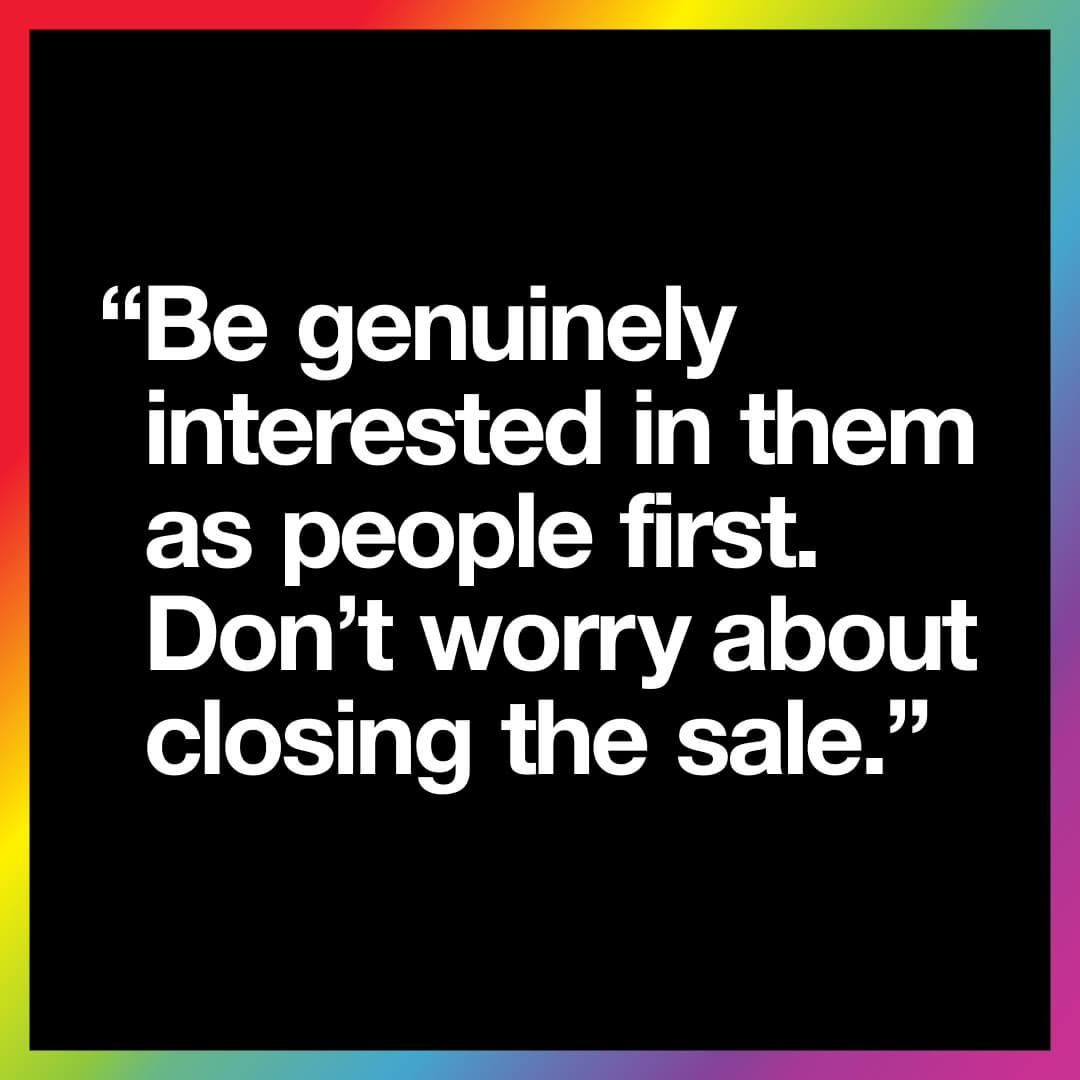
If you can, go see people in person. You can find out a lot about someone by visiting them in their office or where they like to do business. This is a priority because you aren’t just meeting them, but you are also meeting others in the company. But, travel is expensive, and sometimes people are too busy for an in-person chat. If that is the case, try to do a video call. Before the pandemic, people were hesitant about using this method of communication. Now, it is commonplace.
The goal here is to foster a personal connection with your customer by being present in front of them as another person. When everything is email and purchase order-driven, that takes the humanness out of the equation. It pays to show your smiling face.
We always want to make a good impression. I get it. However, some people come across as fake or trying too hard when they project a false facade. Relax. Be yourself. Don’t try to be anyone other than who you are naturally. It’s ok to be nervous or silly. What you want more than anything is to come across as genuine.
Someone asked me the other day for advice.They wanted to know how to determine who makes the purchasing decisions at a big company that they had targeted as a potential customer. They were really worried about it and actually had some anxiety about the situation.
My suggestion was to just call them up and say, “I need your help. I’m trying to find the right person to discuss (what you do). Can you either give me their name or connect me to them?” It worked. Because this person was sincere and honest about what they were trying to accomplish, they were able to not only find the right contact within the company but land the account. It all started with them simply being human and asking for assistance. It is OK to be vulnerable and ask for help.
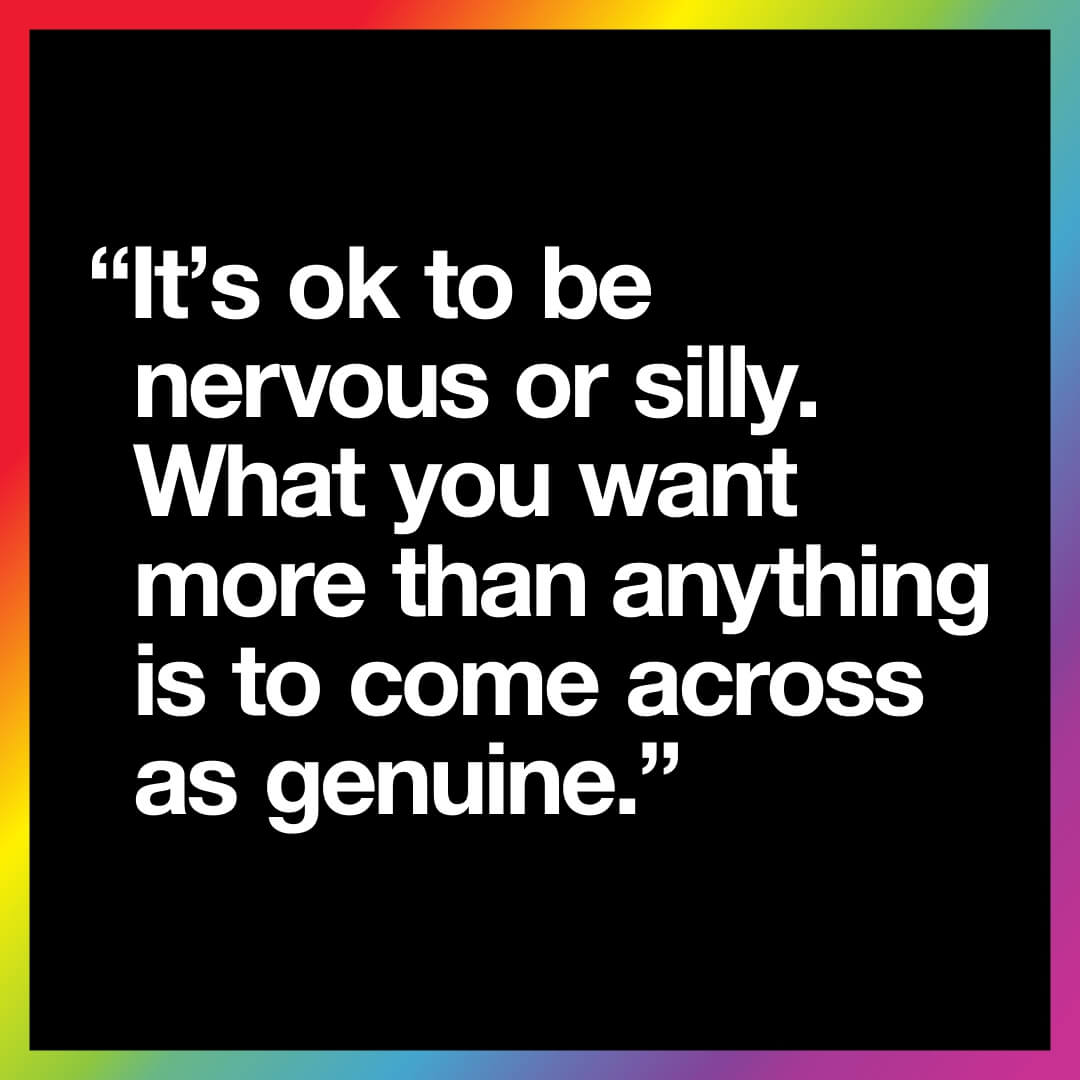
As people, we’d rather smile than frown. Can you inject humor into the conversation when working with a customer? It literally can be about anything. For some, this is going to be tough. As not everyone is naturally funny or has a sense of humor. But that might be enough if you can get that robot-like demeanor to shift into even a half a smirk. Personally, I like making fun of myself. Someone has to do it, right? It’s a good topic because I’m always present in the conversation. Happy people buy more stuff.
I call this technique “Beat the Clock.” For example, let’s say that you will send your customer a quote or follow up with an answer to a question they asked. Whatever time you stated to them, try to get it in early. If you said 3:00 in the afternoon, try to have it ready just before lunch. By tomorrow means, before you leave today. In the next hour means in about thirty minutes.
Holding your end of the deal and getting it in early will always do wonders for your reputation with the customer. Why? Because so many other companies fail to even return calls. Here’s another tip. Even if you don’t have the complete answer yet. “Hey Fred, just wanted to follow up with you. I’m working on that answer, but I’m waiting on the FedEx manager from Topeka to call me back. He hasn’t yet, but I’m on top of it.”
This is important because without hearing from you, people will fill in their own answers in their heads about the situation. “Well, I guess they don’t care about me. They haven’t called me back.” Or, the time-tested favorite, “They didn’t respond. That means they don’t want my business.” Your goal is to make every other person and company they deal with pale compared to how you operate. Personal connections and credibility are solidified every time you follow up early about something. Consistency is the key.
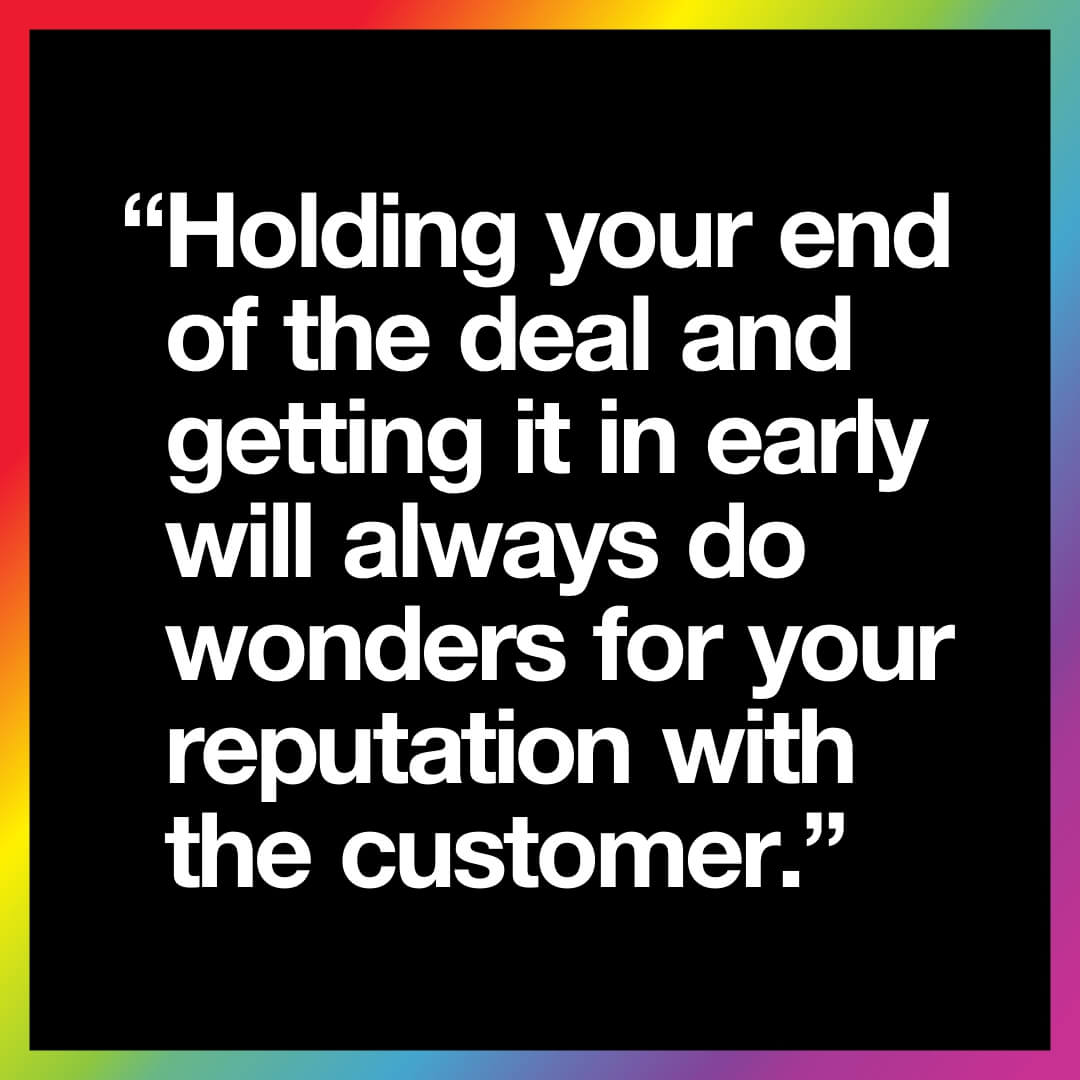
We have a vast array of ways to communicate with our customers these days. Email, text, phone, in-person, instant messaging apps like Slack, and even good old-fashioned snail mail. Do you know your customer’s preference? As not everyone's the same, you can’t treat how to communicate with them equally. While some people like emails (that’s me!), others prefer phone calls or text messaging.
The omnichannel approach allows you to meet your customer with how they like to do business. Remember, it isn’t about you or your company and how you want to do it. Communication is all about your customer and what makes them the happiest. So, can you send an art approval by text? Can you embed a video in an email?
What you want to build more than anything is a platform to reach your customers with the preferred method. To find out, simply ask them. If you have a CRM tool, this information gets logged in, and the preference flows from there. Finding out how they would like to be contacted is as easy as asking them.
While your competition is focused on being order-takers, you might consider working on innovation. Let’s name this task “Think Create Prepare Surprise,” or TCPS for short. Here, you develop new ideas specifically for your customer before they ask. For example, when I was an art director, we would iterate dozens of designs for customers and present them to the customer. In the bunch, a few were chosen, and we would be producing those designs as reorders throughout the year. Millions of shirts were sold. Did it cost money, time, and effort? You bet.
Instead of waiting for orders to come in, work on building a better personal connection with your customer by helping them make more money. In my example, those key customers didn’t ask for the designs. Instead, we dreamed them up, created the samples, and surprised them with a presentation. I know from personal experience how valuable a TCPS program can be. If I’m helping my customer make more money, don’t you think that will solidify that relationship? The effort and cost are nothing compared to customers that don’t view you as a commodity.
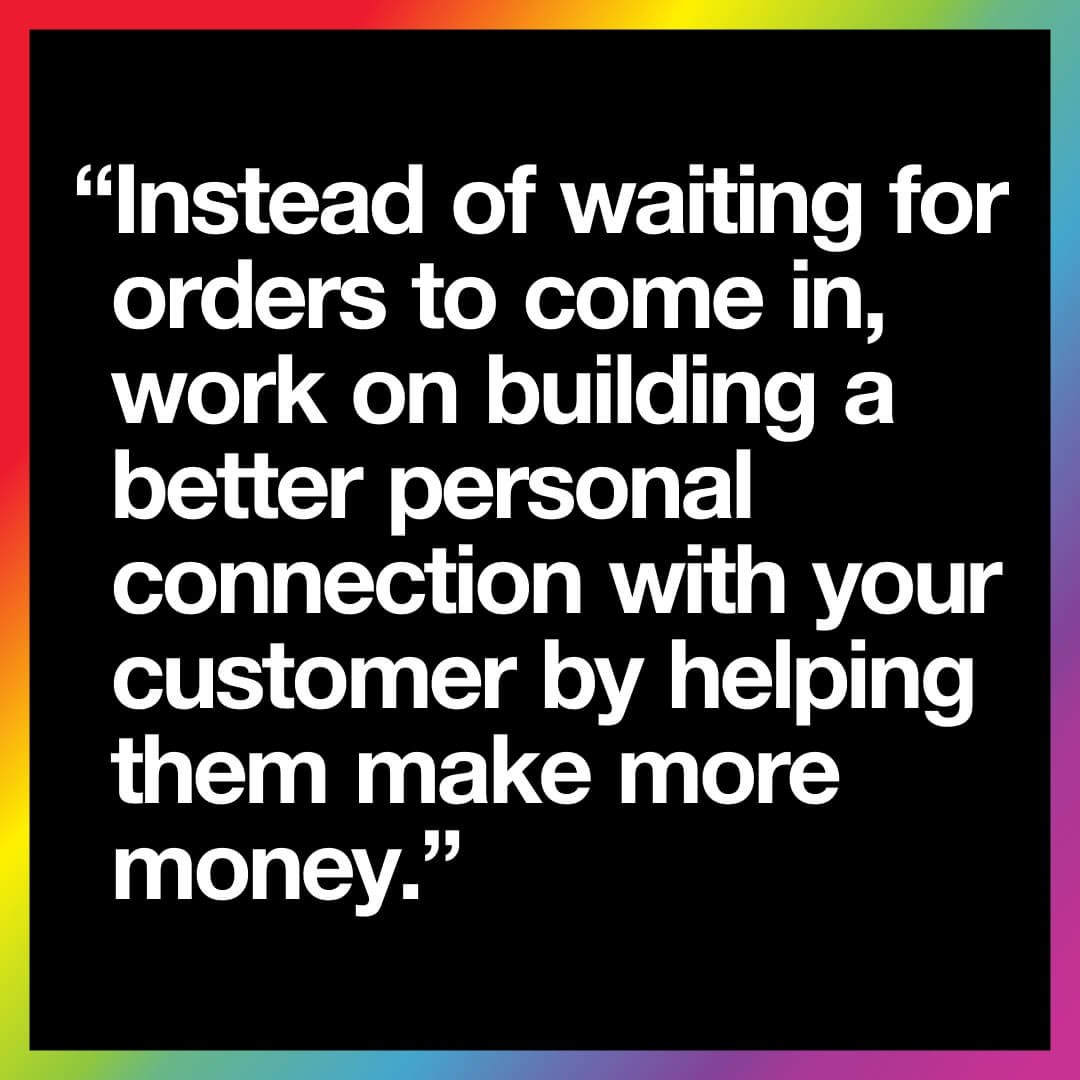
Lastly, and probably most importantly, ask this question. “What do my customers want?” If you want to be more valuable to your customers and foster a deeper connection with them, you have to see things through their eyes. Ask questions about the purpose of the project. For example, let’s say that you are talking to a potential customer from a local school. They contacted you for a quote. Sure, you can get the quantities and work up the numbers. No problemo. But what if you asked more questions?
What if you found out that the primary purpose behind the shirt order was to be a fundraiser for a capital improvement project for the school? By digging into their intent behind the project, you have unlocked the opportunity to discuss how you can build them a print-on-demand online fundraising store. Now, in a short period, you are producing apparel for that fundraising program and the football team, marching band, and even the debate team. By working on deepening the connection between your customer and your capabilities, you have increased the opportunity for more sales by strengthening your personal relationship.
Recently I had the pleasure of taking a private marketing class from the incredible Mark Schaefer. Mark is a gifted writer and storyteller and once was a student under the legendary Peter Drucker.
During the class, Mark told the tale of how Drucker would emphasize a particular point in a lesson with the phrase, “...but, is the dog barking?” This was an allusion to the Sherlock Holmes story “The Adventure of Silver Blaze,” where Holmes solved a mystery where a dog that should have been barking wasn’t. Therefore the suspect had to be someone the dog knew. This is important because if you are in a situation and expect to hear a “dog barking,” and it is not, don’t ignore that clue! This could be the one thing that provides you with the information that other people might miss.
Think about anything and everything you buy. Whether it is ice cream or a new car, something about that particular brand convinces you to make that purchase. This is the dog that constantly barks. It is personal and is not always about features, benefits, or even price. It is about emotion. How does the brand make you feel?
Smart? Happy? Relieved?
Until one day, it doesn’t. Something about that brand changes for you. It doesn’t make you feel smart. Or happy. Or relieved. It might make you feel dumb. Frustrated. Angry even. And now, let’s flip that. Let’s not talk about you. Let’s talk about your customer.
When a customer calls your company to complain, they are the barking dog. They still love you. That’s the reason they are complaining. To give you a chance to fix it. They want you to hear their bark to show you they still care. Embrace that bark! That bark means you still matter to them in some way. But when the dog doesn’t bark? That customer has moved on. They don’t love you anymore. Somewhere out there they are running with a different pack that doesn’t involve you.
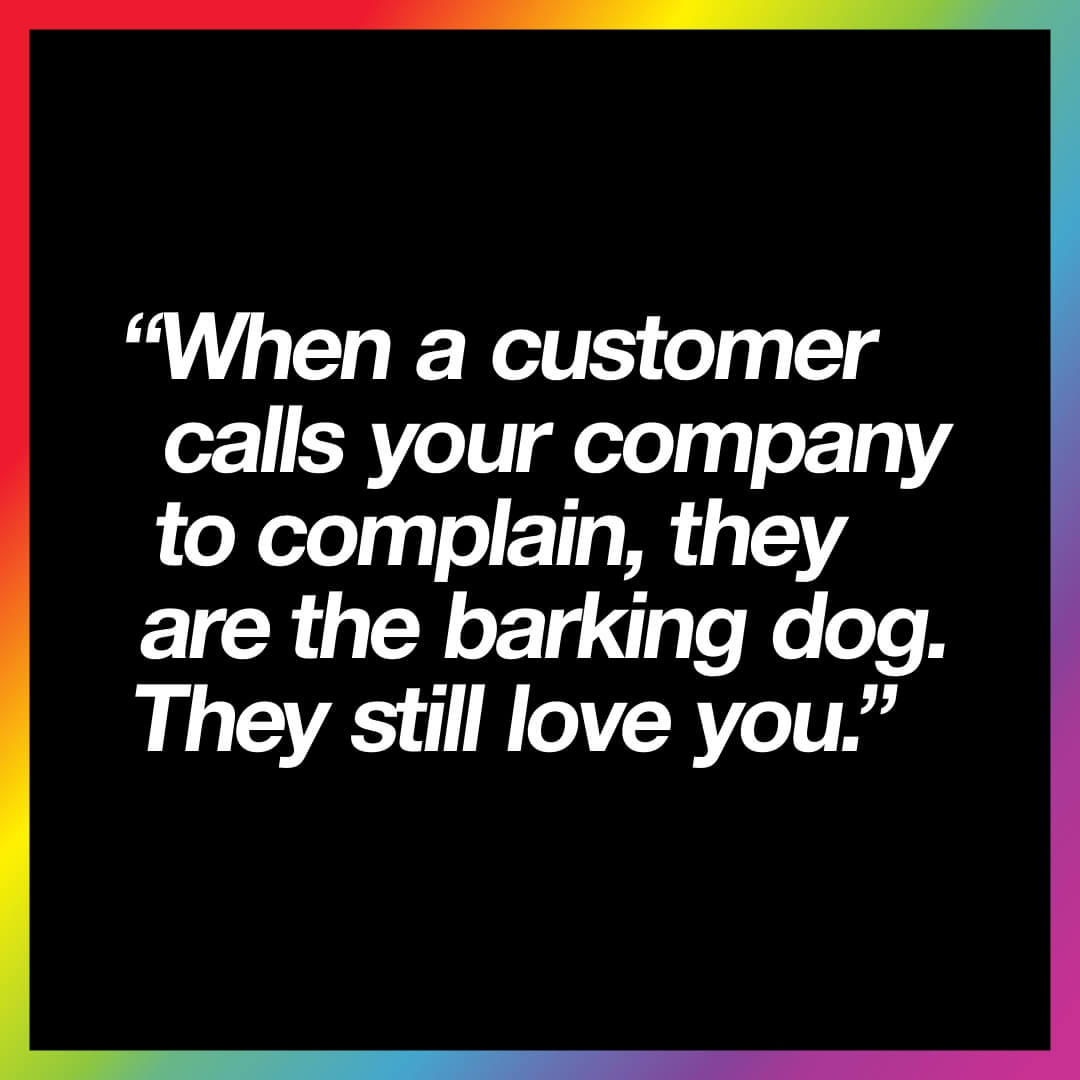
Here’s the question of the day.
Do you even notice? Can you run a history report of your customers over the last three to five years? How many are still active? Count up the silent dogs on the list. How big is that number?
Why is this important? Let’s say that you have a customer that has an excellent relationship with your company. They have been a client for years. You have a solid rapport and have never had any problems with anything. Then one day, you notice that they have been relatively quiet lately. Yep. That dog isn’t barking. So you call up the contact you’ve had throughout your relationship. You discover that this person is no longer with that organization. Instead, they took a job with a different company.
“That’s ok,” you say, “I’m just calling about your next shirt order. I’d like to speak with the person handling that now.”
Can you feel that brick in your gut just reading that? You know what comes next.
“I’m sorry, but the new person has brought in their own vendors. So we won’t be needing your services now. Thank you.”
Ouch. What changed? You can say that you “Didn’t do anything wrong,” but that is not precisely correct.
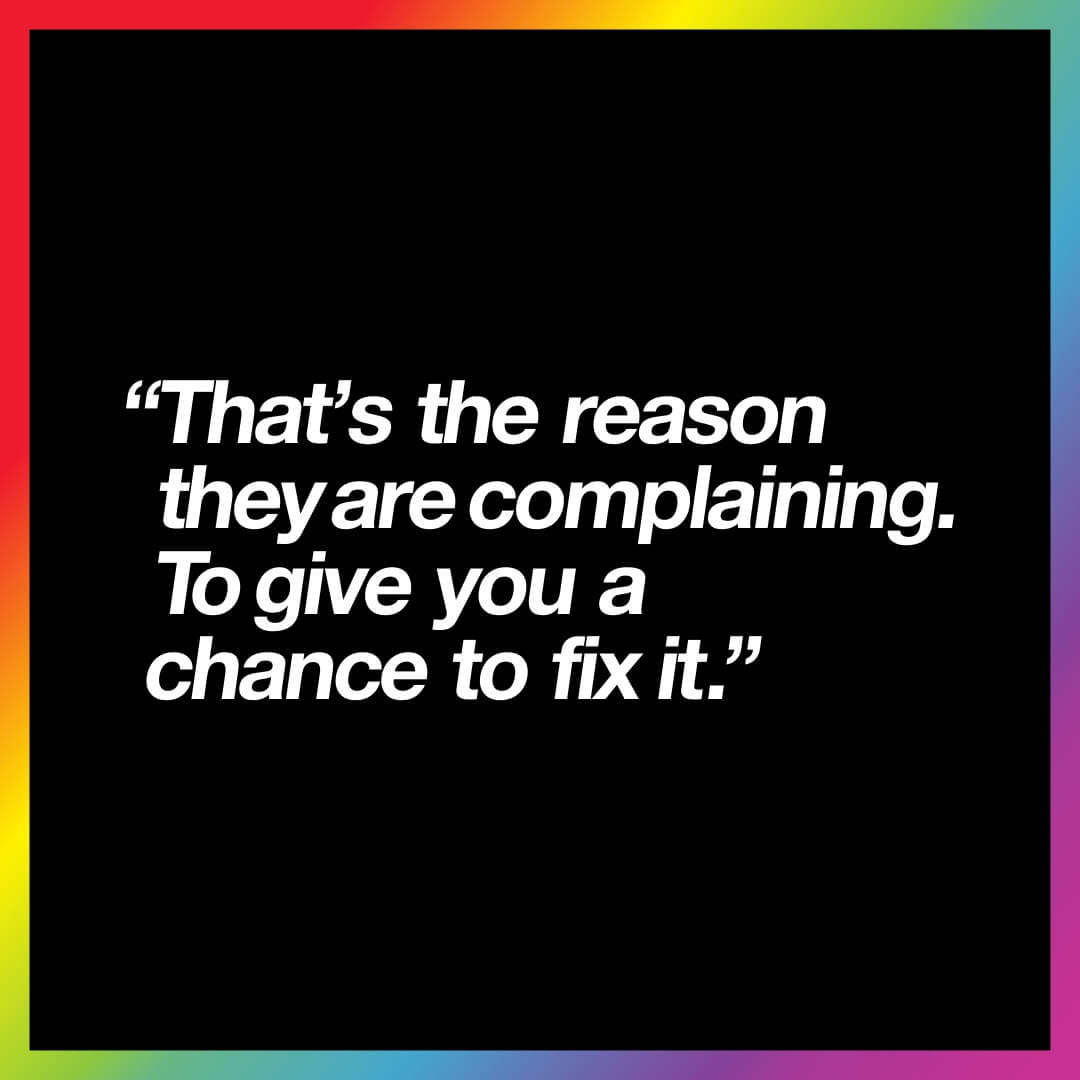
Suppose you had a better relationship with the company and not just with one person. In that case, you could have jumped into the queue with the new decision-maker. Maybe there would have been an ally on their staff that said, “Hey, wait a minute, we should still use these guys.” However, many savvier companies have working agreements or contracts set up, so the relationship lasts longer than a particular person’s employment.
How solid of a foundation do you have with any of your clients? If you are only at the tail end of a website click or purchase order send, you might want to solidify that relationship a bit more
Dogs bark to call attention to something. Woof! Woof! Woof! Simply means, “Hey! Over here!”
Everyone in the neighborhood knows that the garbage truck is rounding the corner. Or that there is a squirrel in the backyard. Or just where is that ball with the jingly thing inside? Is it stuck under the couch again? I need some help! The most effective barking dogs are actually those who don’t bark much. Dogs that seem to yap all the time get tuned out. They become instant background noise. On the other hand, when a dog that hardly ever barks let’s out a loud “Whhhhoooffff!” everyone pays attention.
Sometimes I think people bark like dogs.
Some yap incessantly about everything but don’t ever say anything meaningful. And then others rarely speak, but when they do, everyone listens. It is usually something insightful, funny, or profound. In your neighborhood (marketplace), what type of dog are you? Are you being ignored? How do you know?Do you yap constantly, or do people listen in when you bark? “Hey! Over here!”
Let’s get back to how Sherlock Holmes used the clue, of a dog not barking, to solve the crime. What habit or behavior has your customers, suppliers, or employees changed lately? “...is the dog barking?”
No? What has changed?
Let’s face it, after March of 2020, with COVID and our rise out of that predicament, business and markets have been disrupted. Everybody’s behavior has changed, and you could argue that it is not going back.
Now, we have other world events that have further disrupted business. Supply chain issues, challenges related to the war in Ukraine, and the meltdown of workforce availability.
When the dog isn’t barking, does that mean a fracture in the status quo?
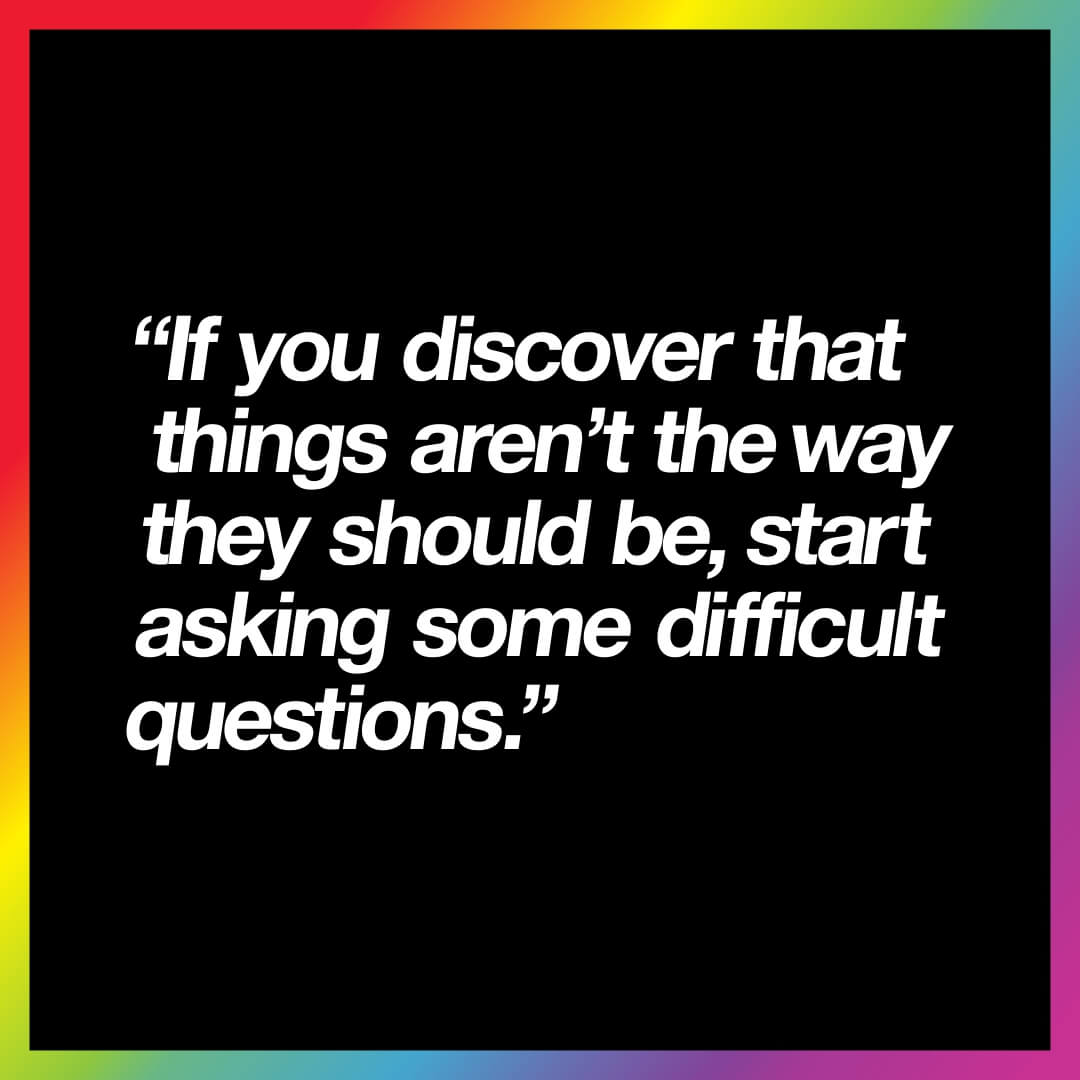
If your customers are faced with anxiety and uncertainty from everyone else, could this signal an opportunity for you to develop a unique solution that catapults you as the dominant leader? Everything right now in business is being renegotiated as we claw our way out of the pandemic resurgence. So now more than ever, people are open to new ideas.
When the dog isn’t barking, that could signal that there is an opportunity to develop something meaningful. But unfortunately, the silent signal sometimes is confusing. It is easy to miss.
If you discover that things aren’t the way they should be, start asking some difficult questions. Why is something happening? Who is frustrated or confused? What changed?
Explore the rabbit holes. Often, they are worth going down.
Pretend for a minute that this is your dog that isn’t barking. Yeah, I know you are probably a cat lover…but bear with me. Wouldn’t you want to know what’s going on with the dog? Not acting as usual could be a sign that something is wrong. So it’s worth getting up out of your chair and checking out, right?Here’s the question, though. Will you be open to what you find? Can it get past your filters and the distracting noise surrounding you and land on your brain and register?
Are you curious enough to explore the seams that might be opening up? Trust me. Many people don’t even realize that the dog isn’t barking anymore. They are going to miss the clue. Therefore, if you start poking around and asking questions and then taking what you find and playing with it…you might find an epiphany. This could be your “Eureka!” moment.
Just to be precise. To be a leader, you don’t need all of the answers. Instead, what you need most is the willingness to be curious and explore. Pull the thread.More than anything right now, you should be asking questions. Be humble. You don’t know what you don’t know.
Pay attention to the new things. These are the new habits and behaviors. The new technologies. New roads are being paved, and you are not traveling down them yet. In fact, maybe nobody is.
Yet.
The dog not barking is what is going to lead you there.
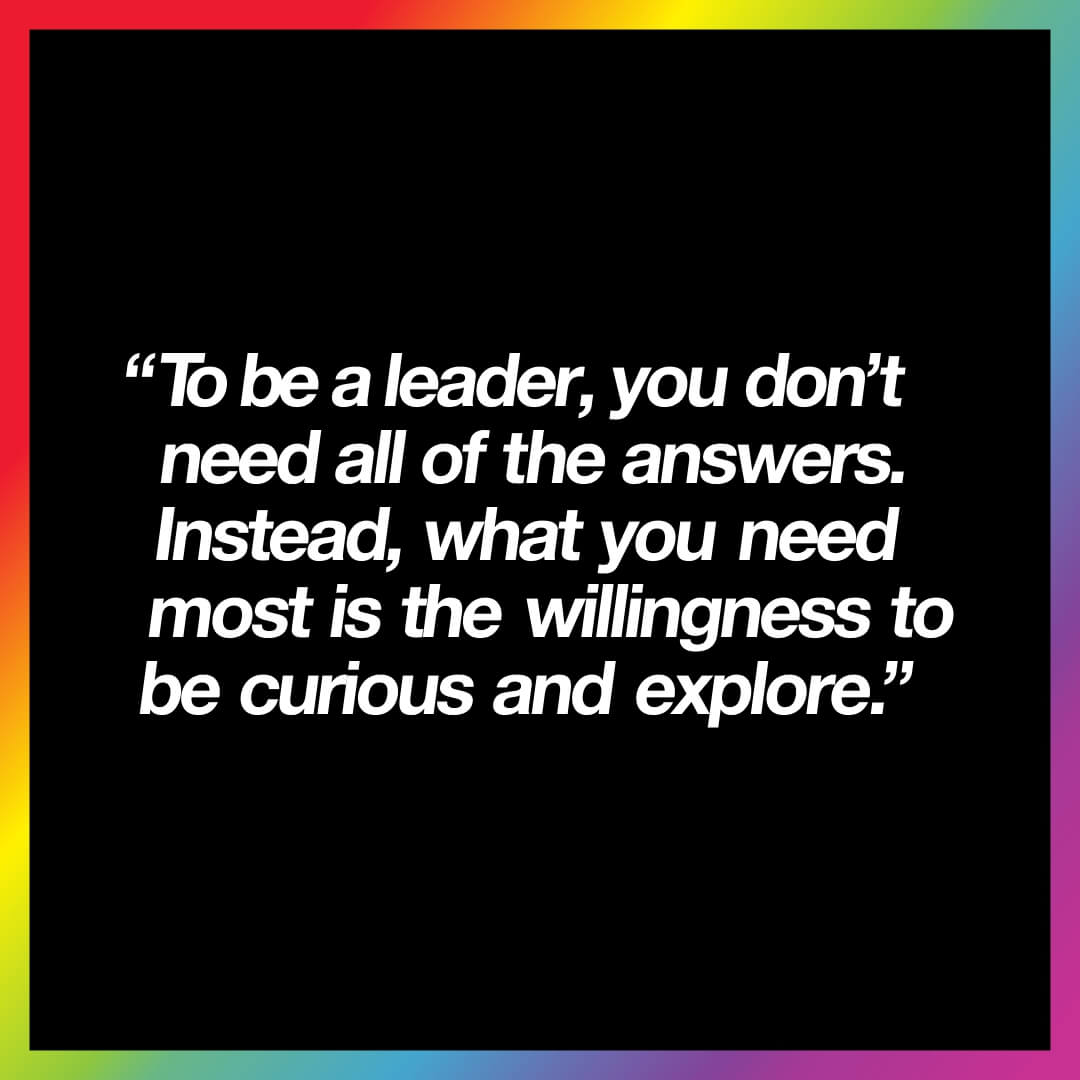
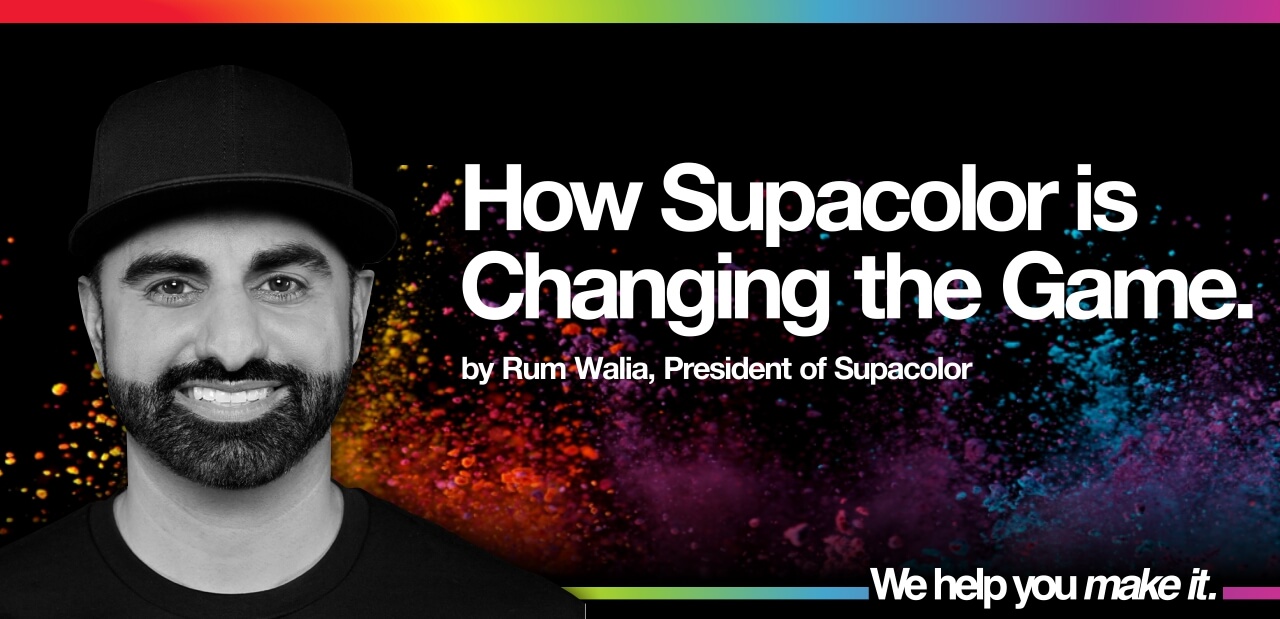
by Rum Walia, President of Supacolor
The story of Supacolor goes far beyond our heat transfers. As we like to say around here, “We’re more than just a heat transfer company.” Our company’s ethos is manifested in our belief that anything is possible and in our aspirations to help others make it. In one sense, by ‘make it’, we help in the making of t-shirts, caps and bags – but what we are really saying is that we help people make it in business and in life. We are forever linked to our Supafam (our beloved customers) because we only exist because of them. When they win, we win. Our success is predicated on how we help people grow, not by how much Supacolor we sell. A heat transfer isn’t much of anything unless it is applied to a garment. In the same way, Supacolor isn’t much of anything without its Supafam community. We’re incredibly grateful to everyone that helped us grow and we are committed to helping those around us do the same.
Supacolor was created by decorators for decorators. The founding partners of Supacolor, Bill Armitt, Mike Modgill and myself, all have experience running our own garment decorating businesses – screen printing is in our DNA. We understand the risks and challenges decorators face every day.
And more specifically, we know the challenges of printing multi-colored designs with gradients on complex fabrics, whether using inks or threads. For example, the combo of a 6-color design and a 10-piece job would make most decorators run for the hills. Running these jobs didn’t make any sense. While everyone else saw a barrier, we saw an opportunity and jumped all over it.
Supacolor was created to solve problems for screen printers and embroidery shops. Allowing them to say yes, when before the answer was no. With Supacolor and a heat press, you could now print anywhere. You no longer needed expensive equipment, a lot of space, or skilled, experienced printers. Creating freedom and opportunity for decorators to grow their business in ways that complemented what they were already doing.
The ambition to solve the problem of printing multi-colored designs was the motivation for inventing Supacolor. Bill and Mike talked about this frequently back then – they didn’t want to stop the carousel presses to screen print complex jobs, but they also didn’t want to turn away customers. They just knew there had to be a better way.
So, they set out on a journey that would see them innovate, collaborate and ultimately bring people all over the world together.
The early days were challenging. Bill and Mike had to find a digital offset press. Getting access to something like this wasn’t easy, especially when it was very experimental. Sticking PET Film through a press could damage it. But they found a used one for sale and made a big bet on the future. With the digital front end in-hand, the guys had to find a way to screen print the rest of the transfer.
Believe it or not, Bill was screen printing the back of the transfers on a hand bench trying to get the registration on point. The limitations and the inaccessibility to equipment didn’t stop them, because the hustler never quits. The one thing that our entire Supateam has always had in common is that we are obsessed problem-solvers. Relentless in the quest to find something better, Supacolor was born.
You’ve probably heard us say Supacolor is the “World’s Best Heat Transfer.” You might think that we’re being arrogant by saying this, but we really believe it. Let me tell you why. Its beauty lies in the simplicity of its construction and the versatility of its performance.
To start, the construction and design of the transfer is elegant. Every Supacolor is created with a combination of digital printing and screen printing techniques, making it a true hybrid transfer.
On the front end, we use the very best digital offset press technology to print every color except white. These half-million-dollar presses are set up with seven colors (cyan, magenta, yellow, black, violet, orange and silver), giving us a broad spectrum of colors that are unmatched in the industry.
Our printing capabilities include Pantone color matching (think T-mobile pink or Coca-Cola red), printing CMYK and specialty matte metallics. We can print graphics super sharp. I’m talking about line weights as small as 1 pt (0.35 mm), so you can print small details. Every. Tiny. One.
We finish each heat transfer off with one of three different kinds of adhesives to print on various fabrics. What’s different about Supacolor is that we’ve created unique transfers specifically suited for different materials. Why? Because we want our transfers to last longer than the products they are applied to. It doesn’t matter if it’s t-shirts, sweaters, caps or bags. Supacolor’s formula is designed to make the transfer look good for as long as possible. That’s why they’re wash tested by a third party lab and proven to last more than 70 washes. We want your designs to look amazing, even when the garment is wearing out. If you don’t look good, we don’t look good.
The real magic of making Supacolor actually starts before we even get to the processes I’ve just described. It begins on the front end with our prepress team: Supaflow. This is where our team prepares the submitted artwork. Anyone that has been in the print industry for even a short while knows that you’re only as good as the artwork you get.
Our team goes to great lengths to ensure that every graphic submitted to us is treated with the utmost care and given the attention it needs to print optimally. This means that if we need to redraw your artwork, we will. At no extra charge. It’s our way of making sure every Supacolor is made to the highest standard.
When you add up the sum of the parts – digital printing, screen printing and Supaflow – you can see why we end up with the World’s Best Heat Transfer. A transfer that we proudly serve up daily, to thousands of customers every month. Each step of the way, we inspect and assure our quality. When we don’t get it right, we don’t blame our customers. We take ownership and make it right, because we’re guided by our daily mantra: Supafast. Supaeasy. Supacolor.
This is more than a marketing line. It’s who we are.
We are Supafast: We understand that a quick turnaround time is critical in this industry.
We are Supaeasy: Nothing is too much trouble. We make it easy for everyone involved.
We are Supacolor: We take pride in everything we do. We don’t settle for good; we aim for great.
I’ve said it before: we are more than just a heat transfer company. We are Supacolor. Everything we do is about the people. It always has been, and always will be. What we do and how we do it isn’t as important as why we do it.
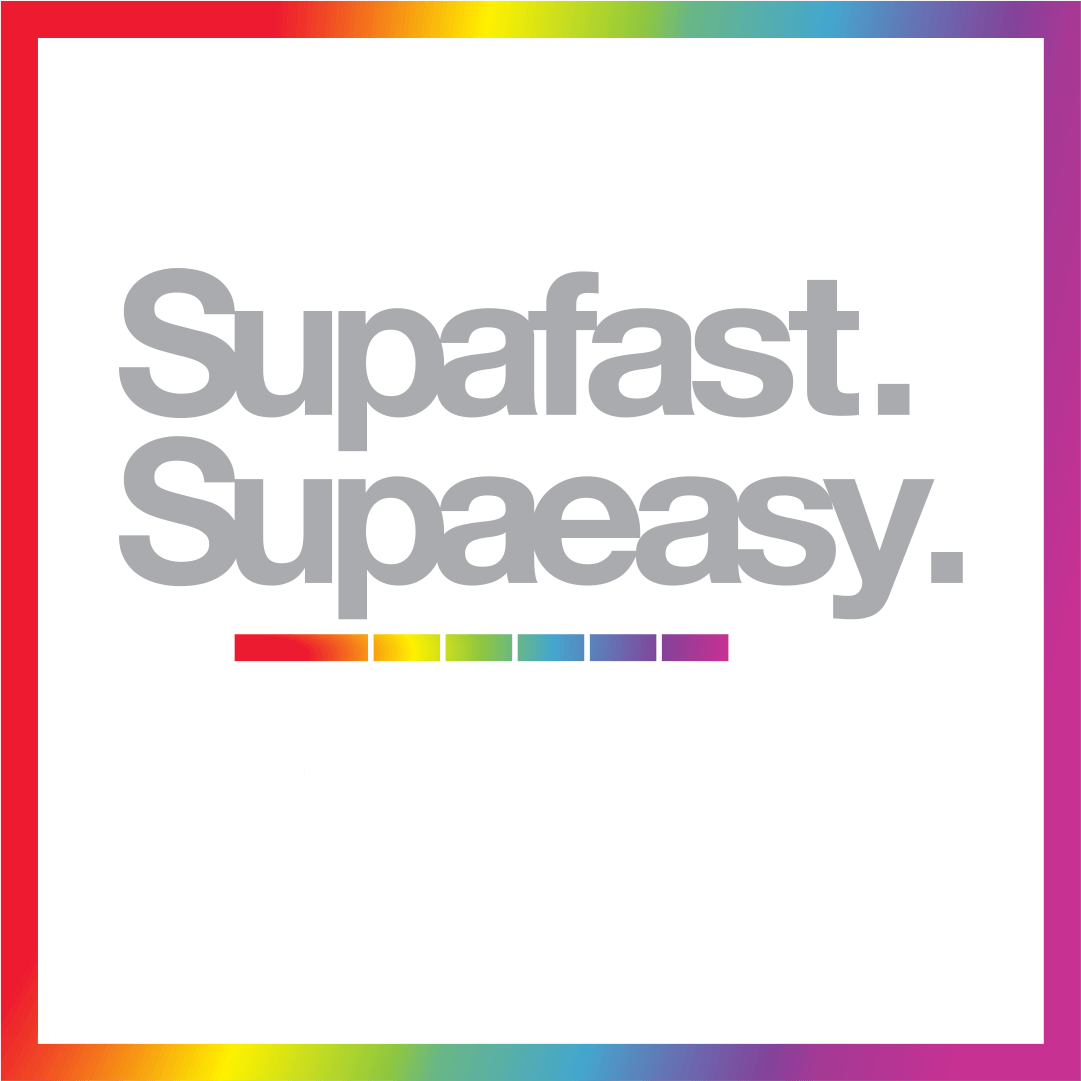
Why do we do it? To help you make it, in business and in life. So let me ask you: how can we help you make it?
Born in Spain and having lived in Mexico for years, Natalia Trevino is a US based fashion designer and the host of the 'Unfiltered Fashion Talks' podcast. Her brand, Natalia Trevino Amaro, creates timeless, classic pieces designed for anyone and everyone to feel beautiful and confident in their own skin. With ethical production being a priority, Natalia makes every item in her shop alongside freelance seamstresses in her own home studio.
And be sure to check out Natalia's TikTok!
https://www.tiktok.com/@nataliatrevinoamaro
With locations in the US, UK and New Zealand, Supacolor manufactures a proprietary heat transfer product, revolutionizing the garment decorating industry by empowering professional printers, clothing brands, brokers, crafters and entrepreneurs. We create the world's best heat transfer, but there's so much more to our story. Our roots are in screen printing and garment decorating, so we know our customers’ businesses – it’s in our DNA. We’ve faced the challenges and risks they’re facing every day. But we believe risk can be managed, and where some see barriers, we see opportunity. And then we jump all over it.
It’s an attitude that runs deep through our business. We’re not just a heat transfer company; we're obsessed problem-solvers committed to finding a better way, relentlessly removing barriers to success. We always put people at the center of our world, creating openness, energy and collaboration. Because where there is positivity, there’s always possibility. And when we work together, that possibility is limitless.
We stand with people who never quit. The hustlers. The hungry. The obsessed achievers. Those who don't just see potential but make it happen – energized and always up for the challenge. We believe this spirit can be cultivated in ways that join people together, igniting innovation and creativity to build great things.
It all comes back to one goal: helping people grow. We’re energizing and advocating for what's possible and delivering the means to achieve it. This lets our customers focus on what they do best: creating, producing, designing, building, selling and succeeding. Or as we like to say, helping you make it.
You don’t have to be a professional graphic designer to create awesome artwork for your t-shirt business! In this video, I walk you through how to create artwork using Canva (for free!), plus how to prepare your artwork and submit it to Heat Transfer Warehouse to create a Supacolor Wearable Transfer.
Click here to Get Started
How Heat Transfers Can Transform Your T Shirt Printing Business
At Supacolor, we make the world’s best heat transfer, but there is so much more to our story. Prior to launching Supacolor, our founders Mike Modgill and Bill Armitt spent many years professionally running screen print and embroidery shops. The garment decorating business is in our DNA! It wasn’t until 2016 that Mike & Bill decided to mix digital printing with screen printing, giving birth to Supacolor and forever changing how garments, headwear and bags could be decorated.
Supacolor was created to address the most common screen printing business pain points: small quantity jobs, made to order requests, tight deadlines, and printing complex, multicolored or photorealistic graphic designs. We provide the tools to allow garment printing businesses to focus on what they do best: creating, producing, designing, and above all SELLING.
So how exactly can Supacolor help your business grow?
Perhaps the strongest case for screen printers to add Supacolor to their toolkit, is the ability to tell their customers YES. Yes, you can take on that small quantity and still make a profit. Yes, you can print photorealistic, unlimited colors and free-floating images without having to count colors or screens. Yes, you can print in tough locations that might be otherwise hard to reach on a pallet. By saying yes to your customers, you can sell more, and we make it Supaeasy!
After submitting your artwork to our website, you’ll have your Supacolor in-hand within days. Your clients have deadlines, and the pressures is on – we get it! With Supacolor, you will be printing in no time. With our industry leading turn around time, most orders in by 12pm Monday through Friday, ship the next business day. And best of all, no rush charges!
The Supacolor application process is extremely easy and does not require a special skill set or extensive training. Anyone with a heat press can print like a pro. Use the equipment you probably already have to decorate more items and grow your business. Get high quality printing with affordable machinery and lower cost labor. Want to grow even more? Invest in a compressed air operated heat press for faster production. With these types of heat presses, Supacolor can be pressed in as little as 10 seconds and with an immediate, hot peel.
Supacolor isn’t just for t-shirts. In addition to cottons, we make our unique transfer-types in custom sizes and shapes, created specifically for a wide array of garments. From sublimated polyesters, to softshell fabrics, headwear or even promotional items like bags, coolers, shoes and umbrellas, Supacolor is the Swiss army knife of decorating. We help you to do more!
Supacolor is manufactured with water-based inks. Our Wearable, Blocker and Softshell Blocker transfers are lab tested to withstand up to 70 machine washes without cracking, fading or peeling. Our transfers have a luxurious soft hand feel, with great stretch and elasticity. Making it an excellent choice for common t-shirt, children’s clothing, and fitness apparel.
Use Supacolor for your most complex or colorful artwork saving your screen print machinery for the more lucrative, simpler jobs. Supacolor your polyester garment jobs so that you don’t have to change your dryer temps to maximize productivity and limit downtime. What about that job for 50 hoodies and a 12-color design? Supacolor it! Don’t spend time counting colors and prepping screens, when you can quickly decorate these with Supacolor and heat press.
Supacolor offers preferred dealer pricing to all professional decorators. This adds to your margins and saves you some money. Does your shop do high volume heat transfer printing? Check in with our sales team to see how we can help you more.
If you would like to find out how Supacolor can help you extend your machinery and say yes to more jobs, reach out to sales@supacolor.com and we will show you how.
Get started today at Supacolor.com.
Does Supacolor Belong in a Screen Printing Shop?
Video Transcribed Below:
Hey guys Kev from Veteran Screen Printing, today we're going to go over no other than Supacolor transfers are they or should they be in a screen-printing shop well we're going to dive into it go over the numbers go over the cost. All right so we've been getting asked a lot about Supacolor transfers so we've ordered some now they do have a minimum of 20. We ordered 50 to get a better price point see exactly how you know it will turn out they came out pretty good looking and we're going to show you how easy it is to actually heat press them on and give you our thoughts on how they feel; we've already pressed them up we've already washed them to give the durability test and we'll let you know exactly how that is. Today we're going to be using a next level 100 ring spun cotton which is the 3600 model which is again one of our premier shirts that we love to print on for screen printing.
Let's go over I got the heat press the heat press is already up and going that 325 degrees is set for 15 seconds now I don't have a drawer to pull out or anything this is just from amazon for $200 so very cheap but it gets the job done and we only really bought it for to do this video. As I do these shirts so I’m going to load it how I would normally load it on a screen press just because I'm so used to that. Now it's 100 cotton so we're going to take our parchment paper we're going to press it down for about five seconds six seconds and the reason why is these are 100% cotton so you want to get all the moisture out of the garment before you do any type of heat transfers. Now that it's already done, we're going to grab our transfer this is a back design put it in the middle four inches down from the collar parchment paper put it back down for 15 seconds so we're running the cost on this and Supacolor actually came out less expensive as what we would actually charge to screen print. It came out just a little bit cheaper but not by much.
It's a hot peel type of application so take it peel back and if you have issues like how it is right now, it's okay because guess what you didn't ruin it! You take this down press it again. Now what I would do is I would just press this again for the whole 15 seconds and you do get this from time to time. I've only had about two out of 50; well I've only printed about maybe 30 of them and I've only had two happen like this and it could be because I was talking and I didn't do a hot peel right away because again it does need a hot peel right away. All right now that it's on there, I'm going to do one more press and this is a pre-press afterwards and this is going to go for about 10 seconds and this is going to make sure that the image is actually embedded into the garment; make parchment paper go back so there's the shirt this is third battalion fifth marines now let's go over this a little bit in detail.
It's has a real soft to the touch feel. Now I had another marine in here earlier picking up some shirts and I had him fill one of these and he actually said that he would actually love wearing this. Probably instead of a big patch of spring printed it's pretty soft to the touch it doesn't feel heavy at all it feels like if I was to screen print and then after screen printing and curing process coming over to the heat press and matte in my ink all the way in that's kind of what it would feel like a little bit of the stretch test. Nothing cracking nothing peeling; again, I have already pressed a whole bunch of these and I took some back to the house and washed them about three four times it stayed intact no peeling no cracking still vibrant colors
So, should Supacolor ultimately be in a screen print shop? Well this depends if you have a design say like this that multi-colors you know you'd have your red your yellow your green your white under base and then if you want to do black overlay instead of the black shirt you know you're looking at minimum four colors, five colors depending on if you want the black. Now say you only have a one station four color press could you get away doing this probably not, you would need a bigger press but could you get away with it if you did Supacolor yes you could. Is there room for you to make a little bit of money still as a screen printer if you did Supacolor? Yes, you could. I'm in San Diego so I still have to compete somewhat with the LA garment district which has the stupidest cheapest prices around. So being in San Diego we still kind of have to compete with that because somebody will drive for an hour and a half just to go there to get garments but like I said I ran the numbers and Supacolor actually came out a little bit cheaper than what I would be charging to screen print this same exact design.
So as a screen printer you could still use this and get done with the job because this many colors means you got to do at least five screens then you got to set up five screens and then you got to print them and throw them through the dryer so if it's only you I guarantee, I promise you if it's only you in your screen printing it on a 6x4 with a conveyor dryer flash dryer the whole nine yards I guarantee you just the back design is probably going to take you at least two minutes maybe about a minute and a half per shirt and then as well as the front is going to be at least a minute and a half to two minutes as well so you know it's going to take you a couple of minutes to spring print this up your margin is going to be more but your time is going to be longer in the screen printing versus heat transferring this over with Supacolor.
Again, this depends on how you guys want to go about this in a screen-printing shop. You got some customers that actually would love this over screen printing. I found that out today and this was a one of the marines I was picking up unit t-shirts that I printed for their unit so that just opened my mind up a little bit more what else could you really offer as a screen printer that is actually a little maybe a little bit faster unless you had an automatic than screen printing you know this would take me about maybe a minute for a front and back fully done margin's not going to be as much as screen printing but my time is a little bit more worth you know times money right everybody says that so I probably get done with an order faster than I would on a screen printing press a manual screen-printing quest. Now what if I had two of these and they're a little bit better quality
than just amazon you know I bought this just to do this video and print out a couple and see how they actually come out but you know what if i went and got a one with a drawer that opens up and automatic open and I got two of them I could be doing two shirts at once and it's going to definitely save on time. So, again in my opinion could Supacolor be used in a serene pruning shop? Definitely. I would recommend using them
They have a wash test at least of a 50 minimum before it does anything and you know that could be you wearing a shirt once a week for a whole year straight and washing it once a week so that's actually pretty good.
So, this is Supacolor guys I'll leave a link below where you can go check them out this is not sponsored by them they don't even know I'm doing it um and I just want to give you my opinion because there's been a lot of people asking about Supacolor it's been a hot shred lately about Supacolor and what does everybody think of them; especially in a screen printing shop. So, for maybe you know a premium type shirt it came out pretty well but if a premium type brand wanted these it just depends. But you know this is probably a new feature that you can offer them so I would definitely check it out if you're a small-time screen printer and you only have a four-color press this is something that could help you build up a little bit more money faster so you can get a bigger and better press,
Be a leader in the field of customized promotional items! Expand the possibilities of what you can do with a heat press by utilizing #Supacolor Promotional Heat Transfers to print on a wide range of merchandise. Broaden your product offering beyond just t-shirts and start generating additional revenue by printing on bags, shoes, lanyards, umbrellas and more! Learn how to grow your business at Supacolor Promotional Heat Transfers
✨ Open your FREE account: https://www.supacolor.com/get-started/
🎦 Follow us on Instagram: https://instagram.com/supacolor
👍 'LIKE' us on Facebook: https://facebook.com/SupacolorUSA
🦅 Stay updated with our Twitter: https://twitter.com/supacolor
🕺 TikTok with us: https://tiktok.com/@supacolor